By Lash Lashbrook
Bulletin Staff Writer
Brownwood Bulletin
Sunday, March 12, 1978
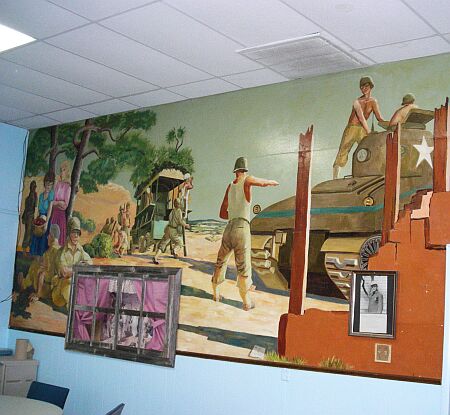
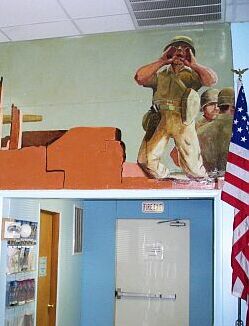
This mural is now located in the
Brown County Museum of History


This mural is now located in the
Brown County Museum of History
| Another
piece of the
puzzle, and perhaps the final piece, of the huge
World War II mural that
covers one wall of the Camp Bowie Senior Citizens
Center fell into place
recently when a brownwood resident found a 34 1/2
year old copy of YANK
magazine.
The weekly magazine carried articles and stories about what was happening in the U.S. Army and on the home front and usually had a full page picture of pretty young lady that often became a "pinup girl" in a lonely GI's foot locker or folded and tucked carefully behind the webbing of a steel combat helmet. It was an Oct. 29, 1943 issue of YNK that a young soldier from Camp Bowie gave to Miss Helen Burt, a Brownwood school teacher, who at that time was the assistant director of the United Services Organization (USO) branch on Lee St. Miss Burt recalls that the Lee St. USO, along with a couple other USOs in Brownwood, were very popular with the soldiers as a place where they could relax for a few ours between the crash courses they were taking at Camp Bowie to teach them the grim art of war. "Our USO, which is a parking lot today, was located on Lee St., next to the Dr Pepper plant," Miss Burt recalled. "Many of the boys that stopped by had been sent down here from the north and had never tasted Dr. Pepper before. It was quite an experience for some who were delighted with the new tasting soft drink. We had good times back then. Our USO was small, and we'd hold dances for the boys with dancing out on the brick alleyway that ran behind our building." Miss Burt had packed the copy of YANK away among her belongings as a souvenir when she moved from Brownwood to Tulsa, Okla. near the end of World War II. She taught school there for 24 years and later returned to Brownwood where she now lives in retirement. A short time ago she "discovered" the old issue of YANK, now yellowed with age. Thumbing through the magazine, she came across an article on page 19 that caught her attention titled, "YANK Mural Contest Winner," and there it was - the mural that was accidentally uncovered in November 1976 by city carpenter Jess Williford as he was renovating the old World War II enlisted men's recreation hall for its new role as the Brownwood Senior Citizens Center. Willford first discovered what appeared to be a small painting of an Army tank when he pried a wood slat off the wall. Carefully removing one slat after another, he soon saw a scene of men in combat, others taking a brief moment of relaxing from the war, unfolding before his eyes. It was soon evident that the painting covered one wall of the large room. Everett Pitts, administrative assistant in charge of public works for the City of Brownwood, was stationed at Camp Bowie during World War II and knew of the painting's existence. In fact, Pitts, who became a Texas National Guard officer after the war, was in the process of insuring the preservation of the art work when he was sent to a service school in Georgia. During his absence, the building was turned over to Government agency which prevented an further action by Pitts. When the painting was uncovered in late 1976, Pitts said, "Do we cover it up again and destroy it or do we attempt to preserve a part of the history of Brownwood - and the world?" He observed at that time that it was strange how things that seemed of not much importance several decades ago take on a new perspective over the years. Some city officials thought the painting too damaged to be repaired, and it looked as though the work of World War II art would be would be lost forever. However, fate reckoned without the timely appearance of Brownwood artists Gene and Winona Pierson who, after studying the faded, nail scarred painting, could see the colors in their minds as they felt the original artist painted them. The couple volunteered their services to restore the painting as their Bicentennial gift to the City of Brownwood. After many weeks and countless hours of back breaking toll that really "became a labor of love," the Persons succeeded in recapturing the mural from the past and brought it into the present where the generations of today and tomorrow cold enjoy a bit of history that was part of Brownwood. But the question remained. Who was the artist? The late Ed Devery, who was a sergeant in the military intelligence at Camp bowie during World War II, recalled a German Army sergeant named Helmuth Rosebruck who worked on the painting as well as a painting of one a turn-of-century photographer taking a photo of a young couple, a picture that adorned a wall of Devery's office at the Army post. A check with the Associated Press office in Germany disclosed a German Sgt. Rosebruck, who had been captured in Tunisia in May, 1943 and interned at Camp bowie until the end of the ear, returned to Germany where he subsequently died during the 1950s. His window told an AP reporter in Breman, Germany that she couldn't conceive of her late husband painting such a picture, he wasn't a painter, she said. A blank wall - that piece of the puzzle didn't fit - yet. George McKay of Brownwood recalled a young Army lieutenant who came into this auto supply store during the war to get some auto paint for a painting that was being made at the Army post. The lieutenant's last name was Hepburn, the same as Katharine Hepburn who was, and still is, one of America's most gifted movie actresses. Struck by the similarity of names, McKay asked Lt. Richard Hepburn if he happened to be related to the famous lady of the screen? The young Army officer replied that she was is sister. The connection of Lt. Hepburn and the painting at Camp Bowie was filed away in one of the recesses of McKay's mental memory bank; a memory bank which contains enough data today to awe any listener as he recalls interesting true stories of bygone days. When news of the discovery of the long forgotten mural was publicized in the late 1976 and early 1977, McKay searched back into that invaluable memory bank and retrieved the data on Lt. Hepburn. However, his recollection was without substantiation. McKay set out to get the proof. He wrote to a movie magazine asking them to forward a letter of inquiry to Miss Hepburn, he contacted radio and television stations in DAllas, he even asked for assistance from television personality Merv Griffin, "who knows everyone in show business." The results were all the same - nothing. Finally, he heard Miss Hepburn was going to make a personal appearance in Dallas. He wrote her associates there asking them to please see that she received a letter of inquiry about her brother, Dick, Camp Bowie and the painting. Weeks went by without word. Just as McKay was about to give up on the thought of ever hearing from her, one of the self-addressed envelopes he had sent to Miss Hepburn arrived in Brownwood last April. In it, on personalized note stationery with "Katharine Houghton Hepburn" across the top in script, was the proof McKay had waited so long to receive. "Yes, my brother Dick was there (at Camp Bowie)," Miss Hepburn wrote. 'He said that an Englishman named Knowlton did the painting over the bar. That he and Knowlton designed the rest. And German prisoners from the Afrika Corps did the paint work." The Hepburn letter answered one question, as to hoe German Sgt. Rosebruck became involved in the painting even though he wasn't an artist. However, it opened up three new questions. What was the bar Miss Hepburn's brother referred to; what were "the rest" that he Knowlton designed; and who was Knowlton? McKay recalled that there was one, and possibly more, officer's clubs on the Army post and several non-commissioned officer's clubs. Apparently Knowlton painted a picture that formed a backdrop for one of several bars in one of the clubs. "Designed the rest?" Of course! If Sgt. Rosebruck wasn't an artist, as his widow said, someone else had to design the mural. Knowlton and Hepburn could have designed it and the painting done by the interned German prisoners of war to keep them busy. The pieces of the puzzle were fitting. But one piece was missing - Knowlton. The latest and perhaps final piece of the puzzle fell out of page 19 of that 1943 copy of YANK magazine that Miss Burt had so carefully saved for almost three and a half decades. A piece of the puzzle that backed up McKay's information he received from Miss Hepburn. For under the picture, in the box titled, "YANK Mural Contest Winner," was the piece of the puzzle. It said, "The painting above of American soldiers in a foreign campaign won the first prize, a $25 War Bond, in YANKS's recent competition for GI murals. Covering a 37-by-seven foot wall in the cafeteria of Service Club Number Four at Camp Bowie, Tex., it is the work of Pvt. Sidney P. Knowlton of Jamestown, N. Y., who is stationed there with the 1853rd SCU. Pvt. Knowlton studied at the Rhode Island School of Design and has had his paintings exhibited at the New York World's Fair and the National Gallery of Arts in Washington." There it was, the final piece of the puzzle of the World War II combat mural that colorfully commands one wall of the Brownwood Senior Citizens Center at Camp Bowie. The
final piece - or is
it? All
murals now stored in the Brown County Museum of
History |
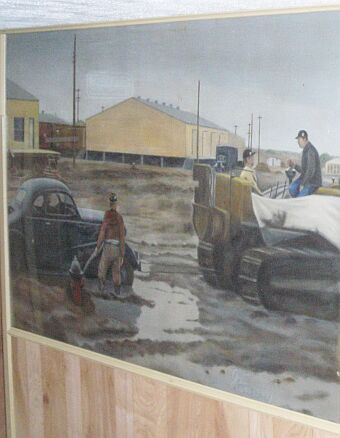 |
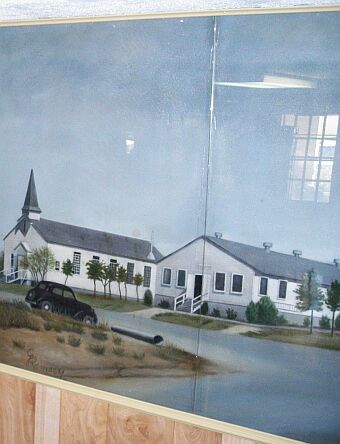 |
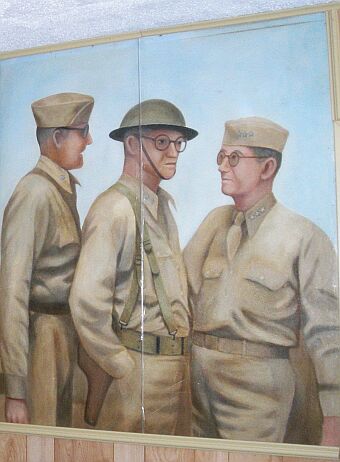 |
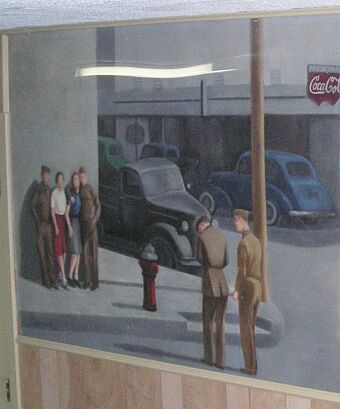 |
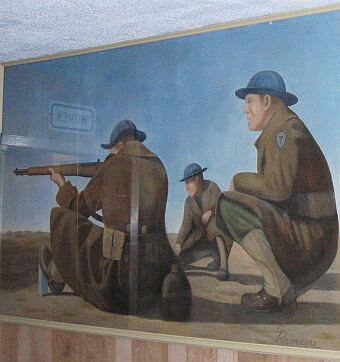 |
Camp Bowie |
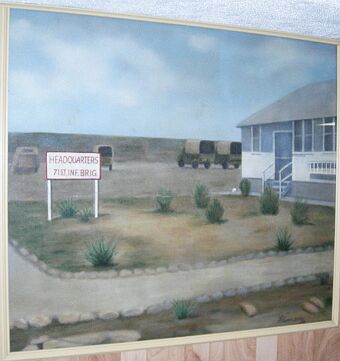 |
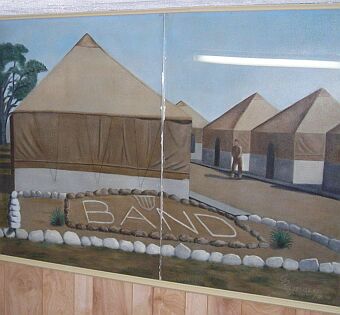 |
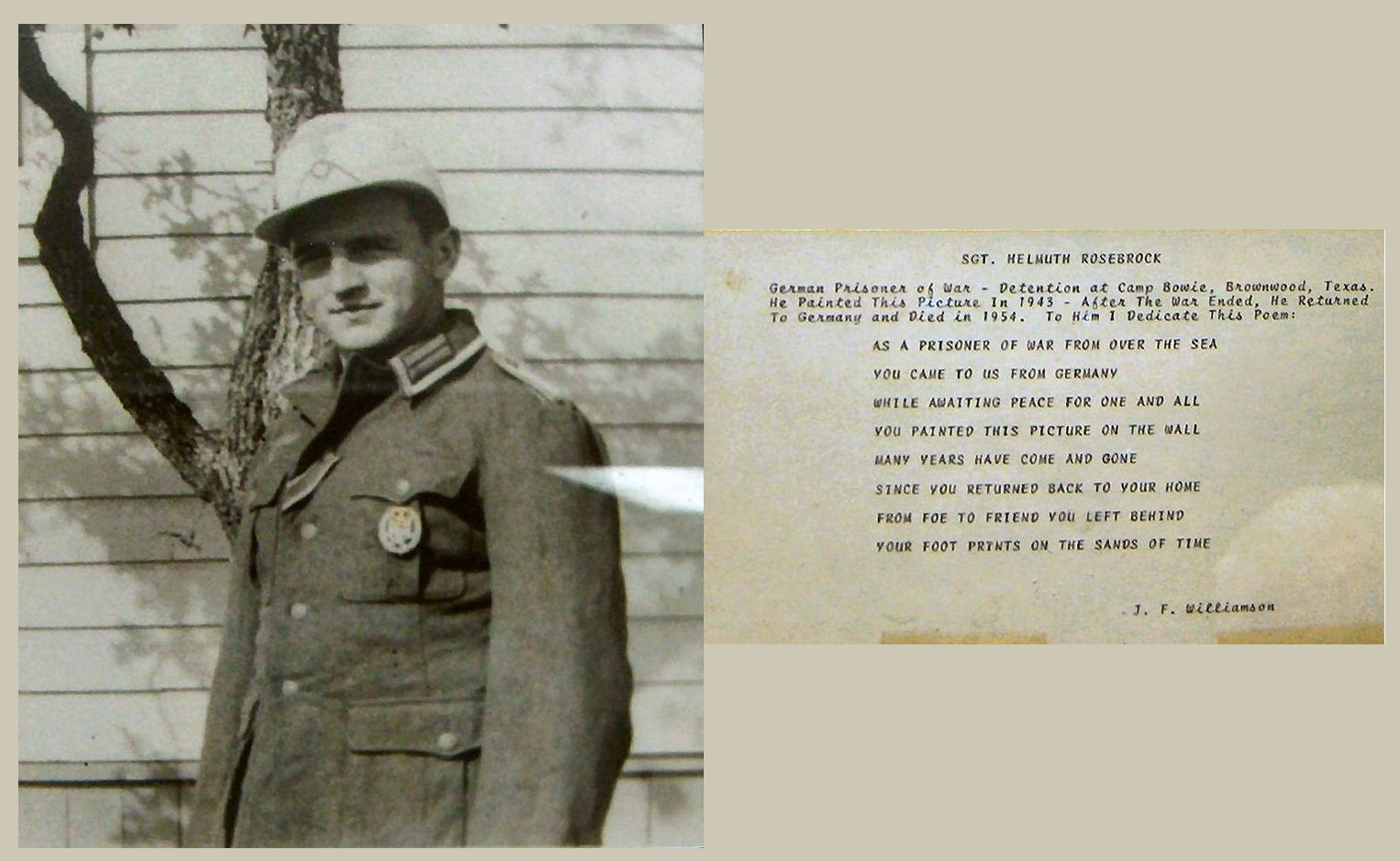 |
| Return
to POW Home Page
Return to Brown County History Home Page |